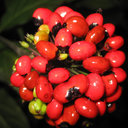De novo Transcriptome Characterization of Rhodomyrtus tomentosa Leaves and Identification of Genes Involved in α/β-Pinene and β-Caryophyllene Biosynthesis.
Raktažodžiai
Santrauka
Plant-derived terpenes are effective in treating chronic dysentery, rheumatism, hepatitis, and hyperlipemia. Thus, understanding the molecular basis of terpene biosynthesis in some terpene-abundant Chinese medicinal plants is of great importance. Abundant in mono- and sesqui-terpenes, Rhodomyrtus tomentosa (Ait.) Hassk, an evergreen shrub belonging to the family Myrtaceae, is widely used as a traditional Chinese medicine. In this study, (+)-α-pinene and β-caryophyllene were detected to be the two major components in the leaves of R. tomentosa, in which (+)-α-pinene is higher in the young leaves than in the mature leaves, whereas the distribution of β-caryophyllene is opposite. Genome-wide transcriptome analysis of leaves identified 138 unigenes potentially involved in terpenoid biosynthesis. By integrating known biosynthetic pathways for terpenoids, 7 candidate genes encoding terpene synthase (RtTPS1-7) that potentially catalyze the last step in pinene and caryophyllene biosynthesis were further characterized. Sequence alignment analysis showed that RtTPS1, RtTPS3 and RtTPS4 do not contain typical N-terminal transit peptides (62-64aa), thus probably producing multiple isomers and enantiomers by terpenoid isomerization. Further enzyme activity in vitro confirmed that RtTPS1-4 mainly produce (+)-α-pinene and (+)-β-pinene, as well as small amounts of (-)-α-pinene and (-)-β-pinene with GPP, while RtTPS1 and RtTPS3 are also active with FPP, producing β-caryophyllene, along with a smaller amount of α-humulene. Our results deepen the understanding of molecular mechanisms of terpenes biosynthesis in Myrtaceae.




